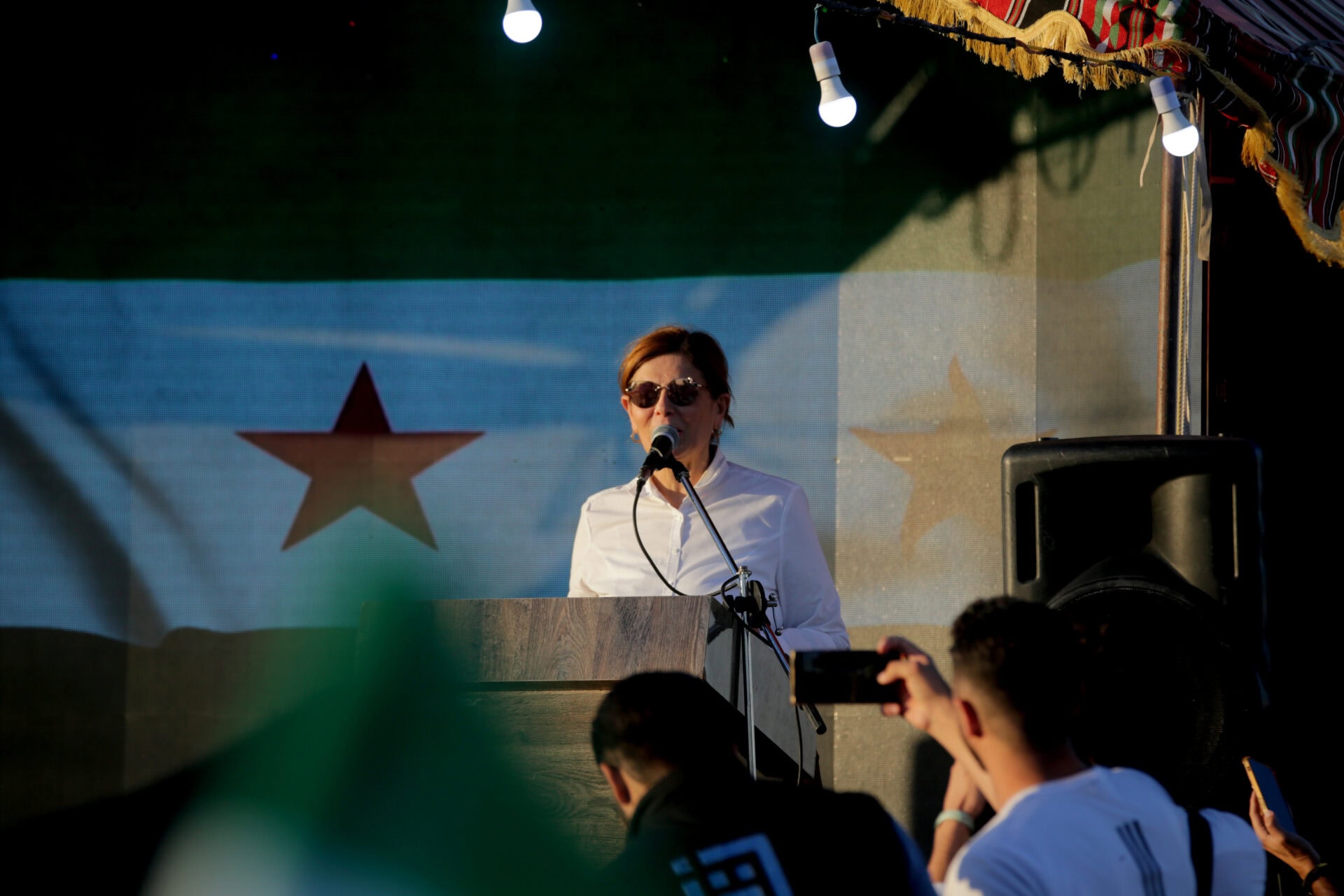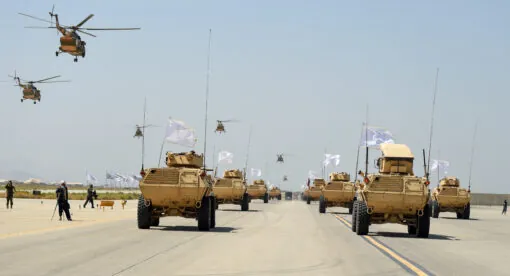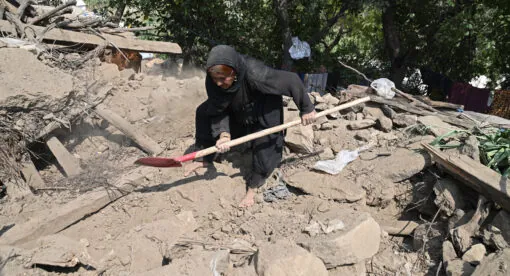The end of Syrian President Bashar al-Assad’s rule has left the country at a critical crossroads, one where interim leader Ahmad al-Sharaa can transform a fractured state to a prosperous, inclusive, and democratic country. Today, the ruling party Hayat Tahrir al-Sham (HTS) faces both unprecedented risks and rare opportunities to reengage with its global allies, most notably the United States. President Donald Trump’s decision to lift all sanctions on Syria signaled a renewed willingness by the U.S. to re-engage diplomatically, granting the interim government led by al-Sharaa a narrow window of opportunity to demonstrate its ability to guide a sustainable peace process, one that prioritizes the rights and participation of women, as well as all ethnic and religious minorities. In a scenario where al-Sharaa succeeds, this will not only legitimatize Syria as an international player but also serve as a testament to his credibility as a reformed leader who steered Syria from the brink of state collapse to revival.
Inclusive political participation and leadership are key for both domestic reconciliation and Syria’s post-conflict rebranding under HTS. Given that women were excluded from formal political processes by the previous regime, al-Sharaa will have to prove that his leadership represents a break from this legacy by placing gender inclusion at the center of his political agenda. The risks associated with entrusting al-Sharaa as Syria’s interim leader is that HTS’s Islamist roots will increasingly shape Syria’s domestic policies, particularly its restrictive roles on women’s rights and political participation. With the spotlight now trained on Syria, al-Sharaa’s approach to inclusion and secular politics will determine the success of his political career.
History
Women in Syria have historically struggled against patriarchal laws, lack of political representation, and socio-economic barriers. Since its establishment in 1963, the Ba’ath party, led initially by Hafez al-Assad, followed by son Bashar, enacted legal reforms intended to improve the rights of women in a secular Syria. For example, Article 23 declared that the state “shall provide women with all opportunities enabling them to effectively and fully contribute to the political, economic, social and cultural life.” Despite the promising wording of Article 23, women in Syria were still systemically denied entry into Syria’s political sphere. At the same time, discriminatory laws persisted under Bashar al-Assad. Women could not pass Syrian citizenship to their children, and Article No. 395 of the Penal Code enabled rapists to avoid punishment by marrying their victims, effectively coercing female survivors into a binding legal relationship with their aggressor.
Women and men alike struggled under the crippling weight of authoritarian rule, but Bashar al-Assad used women’s rights in particular as a tool, as he tightened restrictions on women in response to civil dissent. For Syrian women, demonstrative opposition to the regime resulted in severe reprisals including imprisonment, torture, sexual violence, and, in some cases, death under interrogation. Women were not granted the right to manage their own finances or to move freely, preventing them access to gender-based violence (GBV)-specialized services. These systemic restrictions were also propped up by male family members, particularly husbands, under the guise of protection from sexual violence and abduction while traveling.
Such obstacles to women’s empowerment reflected deeply embedded patriarchal norms, even amid societal collapse. A 2019 report by the U.N. Population Fund concluded that Syrian women faced “violations and discrimination in law and practice” due to the collapse of the rule of law and targeted attacks on women. The report also noted that some women were “forced to work” by their husbands or risked the ultimate threat of divorce upon refusal, placing emphasis on the thin line between empowerment and systemic exploitation in times of crisis.
While the Assads consolidated their political power in Syria using increasingly corrupt methods, Syrian women bore a disproportionate burden as they navigated the threat of GBV and patriarchal backlash, often while raising children in a state of constant fear and uncertainty. The restrictions imposed by the regime deprived women of their right to autonomy, be it as a homemaker or breadwinner. By June 2023, one study found that 74% of Syrian women and girls were in dire need of nutritional assistance. From starvation to forced displacement, the civil war cemented a nightmarish reality for vulnerable women.
Women’s Empowerment and Leadership Under Assad
As the civil war raged, hundreds of thousands of men were conscripted, killed, or detained, creating a power vacuum for women to assume unconventional gender roles. The war created opportunities for women, particularly in humanitarian relief, local governance in opposition-held areas, and diaspora activism, with the latter often met with state-sponsored violence. Moreover, women-led households were still twice as likely as those headed by males to report being unable to meet basic needs.
Confronted with systemic misogyny in everyday life, thousands of women mobilized to demand meaningful political participation. Conversely, they also had to learn how to financially sustain their households to keep their families afloat. As resentment grew toward Assad and pressure mounted, women rejected prescribed gender roles and forged a rebellious path forward, prompting the rise of activists, grass-roots advocates, and educators.
Activists like Muna al-Farij of the Free Raqqa Local Council described Assad’s “inclusion” of women as “symbolic at best.” Al-Farij was one of many who stood on the front lines to demand justice, emphasizing the need for stronger protections for women’s access to education and freedom. These women were instrumental in shaping the resistance that helped lead to the eventual downfall of the regime in 2024. Another powerful example is the late actress and activist Mai Skaf, who famously said, “It is the great Syria, not Assad’s Syria,” a defiant statement turned anthem. Under Assad, women and girls were subject to intersectional trauma, making them the ultimate victims of authoritarianism in a deeply patriarchal system. Although the regime unfairly targeted those most vulnerable, women still emerged as Syria’s greatest asset.
DAANES as a Blueprint for Inclusive Governance
The civil war enabled the demand for women’s inclusion in local governance in opposition-held territories such as the Democratic Autonomous Administration of North and East Syria (DAANES). At the core of DAANES’ model is the belief that to create a secure and stable society, all citizens, including women, must be empowered. This has been exemplified through the promotion of female political leaders like Ilham Ahmed, co-chair of the Foreign Relations Department of DAANES, and legal protections enforced in the northeast, such as the imprisonment of perpetrators of honor killings.
In a recent interview with New Lines, Ahmed said, “We are willing as representatives from Northeast Syria to integrate into the new Syria, but this requires a long discussion and dialogue until we reach some results into implementing the agreement on the ground.” DAANES’ innovative approach to gender inclusion introduced a style of governance not commonly embraced across the region.
Given the positive outcome of DAANES’ model, HTS should recognize the socio-political benefits of granting women the right to lead. Governance in the northeast, led by the U.S.-backed Syrian Democratic Council (SDC), has consistently emphasized that women must be included in political processes, highlighting why Northeast Syria has long served as a blueprint for inclusive governance.
Women’s Political Participation in Syria
According to a U.N. assessment, Syrian woman faced higher rates of poverty than men and an increased risk of GBV. Despite these systemic obstacles, women played a vital role in war-torn Syria, often stepping in as humanitarian first responders, leaders in displacement camps, and vocal advocates for peace. Yet by 2024, women constituted only 12% of the government and 10% of the legislature in Syria, according to the Women’s Power Index, a U.N. metric created to assess member states’ progress on gender parity. Under the Assad regime, women were sidelined in peace and reconstruction talks, prompting strong female representation in grassroots activism as an outlet to amplify their voices instead.
Under HTS, many of these challenges persist. While the creation of new governing bodies suggests potential for progress, HTS has largely recycled existing patriarchal and performative patterns from the previous regime. Recent policies implemented in HTS-controlled areas signal troubling signs of Sharaa’s religious extremist roots, reflected in measures such as segregation on buses and stricter dress codes on public beaches.
Furthermore, the appointment of Hind Kabawat, Syria’s minister of Social Affairs and Labor, drew criticism, echoed similar skepticism after Bashar al-Assad’s appointment of Najah al-Attar’s as vice president from 2006 to 2024. In both cases, critics of the government and members of the international community deemed these political moves to be performative and tokenistic, failing to prioritize women’s political inclusion.
In a recent statement, Kabawat expressed the urgent need to include “more female ministers,” admitting that the new government’s priority remains ensuring ethnic and religious diversity over gender parity. Al-Sharaa’s approach so far signals a troubling long-term pattern of deprioritizing gender equality, flagging to the international community that Syria still lacks a core value critical for successful reintegration into the international system.
While al-Sharaa has made attempts to elevate women in Syrian politics, these efforts have proved untrustworthy, in terms of both quantity and quality of female representation. Most women currently in leadership appear to be aligned with a patriarchal agenda that counters any meaningful progress made by Syrian civil society. If these appointments are primarily intended to appease western allies without addressing the deeply embedded systemic patriarchy, HTS runs the risk of turning women’s inclusion into a purely optical strategy over genuine power sharing.
Women, Freedom and Transitional Justice in HTS-Controlled Syria
Since June 2025, 1.8 million Syrians, including internally displaced persons and refugees, have returned to their homes since December 2024, according to the International Organization for Migration. The responsibility of addressing the grievances and trauma of these millions now lies in the hands of Sharaa. While the pressure to rebuild a state as ethnically diverse and economically frail as Syria is not an easy feat, al-Sharaa and his government have a unique opportunity to leverage international support and translate this momentum into an actionable campaign designed to safeguard the interests and wellbeing of all Syrians, irrespective of faith, ethnicity, or gender.
While there has been some progress in negotiations between HTS and the SDF around self-governance in northeast Syria, recent clashes in Suwayda between Sunni Bedouin tribes and the Druze raise key questions around the success of HTS’ transitional justice efforts. According to the U.N. Office of the High Commissioner, transitional justice is defined as “the full range of processes and mechanisms associated with a society’s attempt to come to terms with a legacy of large-scale past violations and abuses to ensure accountability, serve justice, and achieve reconciliation.” Its core pillars, namely criminal accountability, truth-seeking, reparations, and institutional reform, are key to renewing the social contract between the state and civil society. For HTS, this involves addressing past human rights abuses to encourage societal transformation in a post-conflict zone.
Based on the findings of a gender and conflict analysis by the World Bank, states with low regard for human rights, including gender equality, are more likely to experience militarized and violent interstate disputes. Thus, the need for a truly inclusive government is critical to future incidents of violent conflict in Syria. For reconciliation and conflict resolution mechanisms to be effective, HTS cannot rely on short-term performative shows of inclusion. If true representation of women and minorities is struck within Sharaa’s cabinet, this will reflect in its declining rates of violent conflict, proving that Syria is ready to re-emerge as a viable diplomatic partner and global player.
The Syrian civil war was marked by a high incidence of sexual and gender-based violence (SGBV). While Bashar al-Assad was in power, SGBV was used as a weapon, leaving those who survived left to cope with long-lasting psychological trauma. According to the Syria Justice and Accountability Center (SJAC), SGBV is both a retrospective and preventive measure. Thus, the process of documenting survivor testimonies is critical for establishing protection mechanisms for SGBV survivors.
Research suggests an inverse relationship between women’s empowerment and a society’s susceptibility to violent conflict and instability. For the international community to invest in Syria, women must be recognized for their full potential, judged by their merit, entrusted as leaders, and considered equal to their male counterparts. If the civil war bred a culture of misogyny, efforts made by the new government to reverse regressive societal beliefs around a woman’s inherent value will reveal its true position on gender equality as its political agenda unfolds.
Six months into al-Sharaa’s interim rule, expectations of efforts to prioritize gender inclusion and transitional justice have fallen short. Political leaders appointed by al-Sharaa such as Aisha al-Dibs, head of the Women’s Affairs Office, caused a global stir after her televised comments urging women “not to go beyond the priorities of their God-given nature,” advocating for a Sharia-based model for Syrian women instead of a Western-oriented approach. Dibs’ misogyny proved to not be a one-off case within Sharaa’s Cabinet: Obaida Arnaout, spokesman for the Political Administration of the Military Operations Command Administration, claimed in a public statement that their “biological and psychological nature” made women incapable of assuming certain roles, such as positions within the Ministry of Defense.
Such comments point to a worrying trend of prominent figures in HTS’ Cabinet advocating for sectarian rule in Syria, symptomatic of a lack of ideological diversity in Sharaa’s party. If he pursues a sectarian path, his government is likely to slide into patriarchal authoritarianism, undoing efforts toward women’s rights and transitional justice. Conversely, if al-Sharaa actively chooses to deviate HTS from raw sectarianism, this will position Syria as a democratically aligned state, fit to receive the critical aid and global legitimacy it needs for reconstruction and economic recovery, while empowering women and minorities alike.
The risk of performative inclusion and authoritarianism runs high given al-Sharaa’s history in Idlib province, northern Syria, where freedom of expression was not actively endorsed and strict social rules were imposed, placing him under immense and rightful scrutiny today. For example, headlines in local Syrian media reduced Huda al-Atassi, a member of the organizing committee for Syria’s national dialogue conference, to her identity as a “Sunni Muslim” and Kabawat to her identity as “Christian.”
Under the Assad regime, Syria was known among locals as the “Kingdom of Silence,” a reflection of the state’s control over dissent and media. Today, the ability of the press to report freely is a crucial indicator of democratic health for Syrian citizens and the international community. For accurate coverage of the country’s political agenda and development, al-Sharaa must break away from systems of suppression upheld by the previous regime and allow media to operate without interference. If journalists cannot report without fear, Syrian locals and their diaspora will lose access to credible information, leaving room for propaganda and disinformation to dominate.
Furthermore, the lack of diverse women’s representation in al-Sharaa’s Cabinet is a critical predictor of stability and security. Research suggests that women’s involvement in peace processes has shown a positive impact on the durability of peace and conflict prevention. In this scenario, Syrian civilians are more likely to deepen their trust in Sharaa’s vision for Syria’s next chapter. Due to the scale of atrocities committed by the prior regime, including arbitrary detentions, enforced disappearances, widespread torture, and extrajudicial killings, a coordinated, top-down national response can only be effective if the initiative is led by an inclusive task force. An emphasis on women’s representation in HTS will encourage victims to step forward and accept state support.
HTS must operate in a mindful manner to earn the trust of skeptical Syrians. Due to the levels of trauma and conflict experienced within Syria, a lackluster approach to inclusivity or signs of a patriarchal, power-hungry leader will trigger further unrest. Thus, high-level political and foreign policy negotiations aside, national ownership of and community participation in transitional justice processes will be a strong determinant of the success of Syria’s post-conflict political transition. Based on findings by the Syrian Network for Human Rights, 2,818 individuals, including 201 children and 194 women, were killed in the first half of 2025 at the hands of both pro-Assad militias and transitional government forces. These figures reflect the failure of this interim government to protect innocent civilians, reinforcing the dire need to embed transitional justice mechanisms within Syria’s new constitution. Without concrete steps toward accountability and community healing, SHNR’s report serves as a reminder that the cycle of violence will persist.
Implementing transitional justice in a fragmented state like Syria is not a simple process. The task requires prosecuting multiple layers of abuse spread over two generations, implicating not only supporters of the Assad regime but also various armed groups and transitional actors. Such a task calls for a well-balanced approach grounded in justice and inclusivity, a critical element that has not been reflected in the initiatives, committees, and events that have been held in Syria since HTS’ takeover. Moreover, recent unrest in Suwayda illustrates the fragility of Syrian society and the volatile nature of sectarian tensions. Such escalations in violence highlight the need for HTS to prioritize addressing the grievances of the diverse Syrian population to avoid internal skirmishes and external interference. Ultimately, while the state must play a leading role in transitional justice, it is still unclear whether HTS will truly prioritize inclusive reforms.
Conclusion
Overall, without genuine commitment to shared governance and official dialogue between grassroots women-led organizations and Sharaa’s government, HTS may repeat the same exclusionary practices that defined the Assad era, focused on symbolic gestures over true transformative action. While recent moves, such as adding a Kurdish language option to the Syrian Arab News Agency’s website, suggest al-Sharaa acknowledges that minority inclusion is essential for international recognition and reconstruction aid, such measures remain largely tokenistic. The U.S. and its allies have made clear that Syria’s opportunity to rebuild and rebrand will depend on concrete steps taken to prevent sectarian violence and advance inclusive governance. International support is not guaranteed and will remain conditional on the basis that HTS’s actions do not come at the expense of U.S. interests. If gender-inclusion and transitional-justice measures are not embedded within the new constitution, the interim government’s hope of governing a stable Syria will remain a far-off aspiration.
Policy Recommendations
- Gender Quotas in Syrian Politics: At least 30% of all government positions must be held by women in all branches of government. Research indicates that authoritarian regimes are built upon systematic patriarchy. If the consolidation of power in Syria is at the expense of women, the U.S. and its allies must leverage their influence to ensure that women are guaranteed several seats at the table in al-Sharaa’s government to engage diplomatically with HTS. Women’s inclusion in governance is a global indicator of development and will signal Sharaa’s genuine commitment to shared governance and democratic values.
- Inclusion of Women’s Civil Society Participation: Ensure that grassroots female leaders and civil society organizations are formally engaged in gender parity discussions, constitutional drafting, and transitional justice initiatives. For civil society movements to progress, state support is critical. The value of civil society initiatives lies in their ability to validate the experiences of women and other vulnerable groups traumatized by the prior regime. For the U.S. and the West to collaborate and invest in the growth of Syrian civil society, HTS must empower this sector and allow it to flourish.
- Establish a National Commission on Transitional Justice: Create an impartial commission with the responsibility of monitoring and recording cases of GBV, suggesting legal protections, and incorporating women’s rights into reconciliation efforts. With such a mechanism, women can report on cases of repression and highlight progress in Syria made toward women’s agency, participation, and leadership. Ample and unbiased data collected and reported by the Transitional Justice Commission will inform the U.S. of HTS’ proactive approach to stabilize Syria.
- Reinforce U.N. Security Council Resolution 2254: The U.S. should reaffirm its commitment to the resolution, which outlines a Syrian-led, U.N.-facilitated political process aimed at establishing an inclusive, nonsectarian system of governance. The unanimous resolution provides the most legitimate framework for a sustainable peace process in post-Assad Syria. By enforcing Resolution 2254, the U.S. can remind HTS and other actors of their obligations to engage in a genuine peace process that ensures the meaningful participation of women, upheld by international law.
The views expressed in this article are those of the author and not an official policy or position of New Lines Institute.






